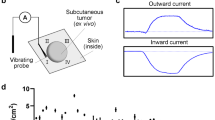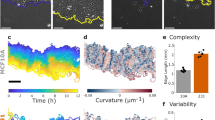Abstract
IT has been reported1,2 that tumour cells have a higher net negative charge than their normal counterparts and that the net negative charge of tumour cells increases with increased invasiveness. It was further reported that decreased mutual adhesiveness of cells is correlated with increased surface charge3. From observations of electrophoretic mobilities of rat liver cells4 and mouse fibroblasts8 it was suggested that increased negative charge is associated with increased growth rate, and Eisenberg et al.6 showed that cell populations with increased growth rate have increased heterogeneity in electrophoretic mobilities. Cook et al.7 inferred from the small scatter of electrophoretic mobilities of individual Ehrlich ascites tumour cells that ‘the electrokinetic properties of the tumour cell surface were independent of the state of the nucleus’. This communication describes an attempt to relate the electrophoretic mobility of cells to their stage in the mitotic cycle.
This is a preview of subscription content, access via your institution
Access options
Subscribe to this journal
Receive 51 print issues and online access
$199.00 per year
only $3.90 per issue
Buy this article
- Purchase on Springer Link
- Instant access to full article PDF
Prices may be subject to local taxes which are calculated during checkout
Similar content being viewed by others
References
Ambrose, E. J., James, A. M., and Lowick, J. H. B., Nature, 177, 576 (1956).
Purdom, L., Ambrose, E. J., and Klein, G., Nature, 181, 1586 (1958).
Ambrose, E. J., and Easty, G. C., Proc. Roy. Phys. Soc. Edin., 28, 53 (1960).
Ben-Or, S., Eisenberg, S., and Doljanski, F., Nature, 188, 1200 (1960).
Heard, D. H., Seaman, G. V. F., and Simon-Reuss, I., Nature, 190, 1009, (1961).
Eisenberg, S., Ben-Or, S., and Doljanski, F., Exp. Cell Res., 26, 451 (1962).
Cook, G. M. W., Heard, D. H., and Seaman, G. V. F., Exp. Cell Res., 28, 27 (1962).
Bootsma, D., Budke, L., and Vos, O., Exp. Cell Res., 33, 301 (1964).
Petersen, D. F., and Anderson, E. C., Nature, 203, 642 (1964).
Ishihara, T., Moore, G. E., and Sandberg, A. A., Cancer Res., 22, 375 (1962).
Moore, G. E., Mount, D., Tara, G., and Schwartz, N., Cancer Res., 23, 1735 (1963).
Mayhew, E., and O'Grady, E. A. (unpublished results).
Engelberg, J., Exp. Cell Res., 23, 218 (1961).
Bangham, A. D., Flemans, R., Heard, D. H., and Seaman, G. V. F., Nature, 182, 642 (1958).
Dustin, P., Nature, 159, 794 (1947).
Walker, I. G., and Helleiner, C. W., Cancer Res., 23, 734 (1963).
Author information
Authors and Affiliations
Rights and permissions
About this article
Cite this article
MAYHEW, E., O'GRADY, E. Electrophoretic Mobilities of Tissue Culture Cells in Exponential and Parasynchronous Growth. Nature 207, 86–87 (1965). https://doi.org/10.1038/207086a0
Issue Date:
DOI: https://doi.org/10.1038/207086a0
This article is cited by
-
Microfluidics for cell separation
Medical & Biological Engineering & Computing (2010)
-
Cell contact phenomena
In Vitro (1970)
-
Synchrony in cultured animal cells
In Vitro (1970)
-
Changes in Surface Charge of HeLa Cells during the Cell Cycle
Nature (1967)
Comments
By submitting a comment you agree to abide by our Terms and Community Guidelines. If you find something abusive or that does not comply with our terms or guidelines please flag it as inappropriate.



